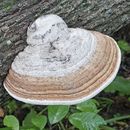Comprehensive Description
provided by North American Flora
Elfvingia megaloma (Lev.) Murrill, Bull. Torrey
Club 30: 300. 1903.
Polyporus megaloma L6v. Ann. Sci. Nat. III. 5 : 128. 1846.
Polyportis leucophaeus Mont. Syll. Crypt. 157. 1856. (Type from Ohio.)
Fomes megaloma Cooke, Grevillea 14 : 18. 1885.
Pileus hard, woody, dimidiate, applanate, 6-15X8-30X1-4 cm.; surface milk-white to gray or umbrinous, glabrous, concentrically sulcate, encrusted, fasciate with obscure lines, conidia-bearing, usually brownish during the growing season from the covering of conidia ; margin obtuse, broadly sterile, white or slightly cremeous, entire to undulate : context corky, usually rather hard, zonate, fulvous to bay, 5-10 mm. thick, thinner with age ; tubes very evenly stratified, separated by thin layers of context, 5-10 mm. long each season, avellaneous to umbrinous within, mouths circular, 5 to a mm., whitish-stuffed when young, edges obtuse, entire, white or slightly yellowish to umbrinous, quickly changing color when bruised : spores ovoid, smooth or very slightly roughened, pale yellowish-brown, truncate at the base, 7-8 X 5-6 ii.
Type locality : New York.
Habitat : Abundant on dead or diseased trunks or timber of most deciduous trees ■ also on conifers in certain sections. ' '
Distribution : Canada to the mountains of Alabama and west to California
- bibliographic citation
- William Alphonso MurrilI, Gertrude Simmons BurIingham, Leigh H Pennington, John Hendly Barnhart. 1907-1916. (AGARICALES); POLYPORACEAE-AGARICACEAE. North American flora. vol 9. New York Botanical Garden, New York, NY

